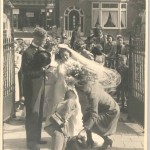It worked.
For all our fears: that it would rain; that we would run out of food; that we would not keep up with the drinkers, of whom as it turned out there were only a few; or that some other unknown unimaginable disaster might befall us on the day; it worked.
And in an hour or two when every one else is up and about, the next stage of the clean up will begin, a clean up that includes a post mortem of proceedings, one of my favourite times after a significant social event, when we all get to gossip and reminisce about who said what and to whom.
Where we crow about the joys of the day and pat one another on the back that all our preparations have paid off and from time to time we might remark on something small that we could have done better, but it will only be small.
As the groom’s father left our house at the end of the day, he patted the bride’s father on the back – they’d both had a bit to drink – and said something like, ‘You’re the best person I’ve met in a long time.’
Such a compliment to my husband and even through the alcohol you could tell it was sincere. Small exchanges like this help to bring these two new families together. Now united through the marriage of our two children.
It’s one aspect of marriage that I relish, the bringing together of tribes, of families of people who would otherwise not connect. For all our differences we have similarities.
My parents’ marriage in Haarlem and my husband’s parents’ marriage in Mansfield, Australia could not be further apart, though both brides wore white veils, both carried bouquets and both their grooms wore suits. My father wore a top hat.
Both marriages happened in the shadow of world war two and in both cases you could not see the trimmings of war in the background.
I long admired the fact that my mother and father were such contrasts in height, my father six foot three, my mother five foot two Even those measurements held some synchronicity.
I do not know the height of my husband’s parents though both were short. My mother-in-law wore glasses on her wedding day, as did my father.
And all four young marrieds had the thin look of hunger from working hard, whether on the land, as did my husband’s parents; or through war as did my parents.
When my husband and I married we failed to please either set of parents by sharing the tradition each upheld of marrying in the Catholic church. We chose instead the Religious Centre at Monash University where my husband had once studied.
I’m all for receptions held at home. The personal touch. My oldest daughter married in her own home, my second daughter had the reception in her home of origin. Home can be wherever we want it to be, but it’s a place where the small children, and there were several at both weddings, can run amuck in relative safety.
Not one child fell into our pond, not one child fell while running, though there were a few brawls among our two grandsons, none of great import, not that I could see and both boys managed to hold onto the rings during the service for long enough that they could in time hand them over to their grandfather who became the ring bearer on the occasion as he had made the rings.
Two daughters married, as Mrs Bennet from Pride and Prejudice fame might say: two daughters married… ‘I shall go distracted’.




